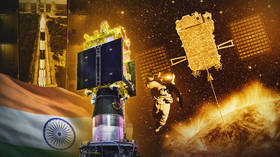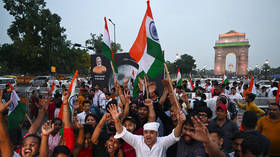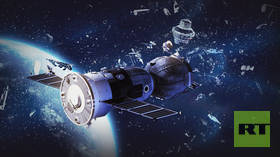Surya Namaskaar: A daring space mission aims to stop the threat emanating from the Sun

Ten days after Vikram’s historic landing on the Moon’s south pole region, Indian space scientists will reach for the Sun, quite literally.
On Saturday, September 2, an Indian Space Research Organisation (ISRO) spacecraft will commence a 1.5 million km trek to beam home a humongous amount of details on the Sun’s activities.
Aditya L-1 (Aditya is Sanskrit for the Sun), with seven scientific payloads, will cruise for four months to reach the so-called Lagrangian point (L1) – named after the Italian astronomer and mathematician Joseph Louis Lagrange – about 1% of the distance between the Sun and the Earth.
According to ISRO, Aditya L-1 payloads are expected to provide crucial information to understand the problems of solar phenomenon, such as the heating of the outermost layer of the Sun’s atmosphere, the corona; the ejection of magnetic field and plasma from the corona, which is technically called the coronal mass ejection (CME); solar flares and pre-flare activity, and their characteristics; space weather dynamics; the study of the propagation of particles and fields into the space between planets.
The data on such phenomena will help in diverse ways. Solar flares have an impact on the El Nino effect warming Earth's oceans, which determine global weather. Solar flares have caused blackouts in Russia, and one of the largest accompanied a CME in 1989, blacking out the entire province of Quebec, Canada, for 12 hours. The Carrington Event of 1859 was one of the strongest solar flares recorded, releasing as much energy as ten billion megatons of exploding TNT; telegraph operators at the time even felt an electric shock while typing out telegrams.
What is under wraps is that data beamed by this solar probe will help the IAF train its pilots as part of the plan to raise an astronaut corps on the lines of that at NASA. The data will definitely be used for pilots undergoing training for India’s first human spaceflight program, Gaganyaan.
Around the time of the August 23 landing of Vikram from the Chandrayaan-3 lunar mission, the first batch of IAF officers was provided with a detailed briefing on all aspects concerning space weather, solar activity, and the voyage to outer space by professors of the Aerospace Engineering department, Indian Institute of Science (IISc), Bengaluru. Later, the officers trooped into several Defense Research and Development Organization (DRDO) facilities in Bengaluru.
Working with the IAF, ISRO has already picked four ace test pilots for the Gaganyaan project. Though this maiden flight, with an Indian astronaut on board, could blast off in a couple of years (it fell behind schedule as all tests and operations were halted during the pandemic), these pilots underwent training in Russia but now live in the well-protected campus of ISRO. Their names, under wraps for three years, will soon jointly be announced by Russian President Vladimir Putin and Indian Prime Minister Narendra Modi, sources in ISRO said.
Studying the sun
The Aditya L-1 probe itself was much delayed to its reconfiguration to modify it from a mere scientific mission to much more. Sources said the redesign would now enable the flagging of alerts about solar flares and coronal mass ejection (CME) and changes in space weather – to help ISRO shut down operations of satellites likely to be impacted by such activity.
“We were depending on data shared by satellites of the United States (Geostationary Operational Environment Satellites or GOES series) and those of the European Space Agency (ESA),” sources said. “This mission is not only about studies of the Sun but also about achieving self-reliance in protecting our satellites, telecommunication and navigational aids of airlines. We will share the data of Aditya L-1 (including 1,440 images a day). Still, more importantly, our assets in space must be available to the IAF without interruption.”
The importance of monitoring solar surface activity can be gauged by various events that have impacted Earth. On two days in the first week of August, for instance, radio and navigation signals were disrupted in North America and Canada by two powerful solar flares. Both flares that struck North America and Canada were of the X-class, the most intensive types of solar flares.
Threats to satellites
Like the intensity of the earthquakes, solar flares are graded based on a five-point scale (just like the Richter Scale) and developed by the National Oceanic and Atmospheric Administration (NOAA) of the United States. Their classification depends on the intensity of X-rays emitted.
A solar eruption in October 2021 was detected simultaneously on Earth, the Moon, and Mars. Interestingly, the first-of-its-kind discovery of a CME on three different worlds was made when the Earth and Red Planet were on opposite sides of the Sun with a gap of 250 million km between them.
And the 1989 solar eruption triggered a geomagnetic storm on Earth, resulting in aurora borealis, or northern lights, that could be seen as far south as Florida and Cuba.
Solar flares tend to originate from regions of the solar surface that contain sunspots – darker, cooler portions of the solar surface where magnetic fields are powerful. As such, the number of sunspots can indicate the likelihood of a solar flare eruption. Traveling at the speed of light, the photons from these flares arrive on Earth in eight minutes. As the radiation from the flares interacts with particles in the Earth’s ionosphere (the atmosphere region at altitudes between 80 and 650 kilometers), it supercharges them. These changes then affect radio and satellite signals that pass through this region.
The flare triggers a CME, which is the release of a plasma consisting of charged particles and a large amount of magnetic field that moves at high speed into the environment of the solar system. This plasma ejection can travel hundreds of millions of kilometers from the Sun.
The CMEs that hit the Earth, on the other hand, trigger a different phenomenon – known as geomagnetic storms. The geomagnetic storm in February 2022 caused 40 Starlink internet satellites owned by Elon Musk’s company and launched the day before, to fail to reach orbit and fall back to Earth as fireballs. The increased flow of charged particles increased the density of the Earth’s upper atmosphere. As a result, the satellites could not reach their actual orbit and eventually fell back to Earth.
Geomagnetic storms produce beautiful aurora displays but can also cause satellite operators problems as they swell the Earth’s atmosphere. In the most severe cases, geomagnetic storms can knock out power grids and telecommunication networks. Geomagnetic storms once burned several electrical transformers in Canada, causing power outages in 1989 throughout Quebec, Canada, and Sweden.
Vital probe
Initially, the solar probe was designed with a mere solar coronograph by the Indian Institute of Astrophysics (IIA), Bengaluru, for scientific studies from a point (L-1) where the Sun’s disc would be visible without an eclipse or other occultations. Later, the Tata Institute of Fundamental Research (TIFR) and ISRO added more instruments to take the total number of seven. IIA played a crucial role in the design, integration, testing and calibration of the hardware, says former director Dr P Sreekumar, who played a vital role in missions like Chandrayaan-I, ASTROSAT and Mars Orbiter Mission (MOM) during his stint at ISRO.
He said that while India’s ground-based assets are safe from the flares, charged particles that constitute a part of mass ejections of gargantuan proportions pose a danger to the satellites and future crew-based flights. The probe would provide alerts at least 30 minutes in advance on changes in space weather. This input would immensely help during the coasting of the plasma.
On the scientific component of this mission, Dr Krishnaswamy Kasturirangan, former chairman of ISRO, said,
“Aditya L-I is one of the unique spacecraft designed to study all three layers of the Sun. It will help us understand solar physics like never before. Knowing the Sun better is central to one’s existence on Earth. The better we understand solar activity, the safer are ground-based assets in sectors like telecom, electricity and aviation.”
Military application
The Aditya L-1 probe will also support operations of the IAF besides helping protect the nation’s space-based assets, worth over a whopping Rs 60, 000 crores, say ISRO sources. Its launch coincides with the commencement of IAF’s hush-hush first aerospace training module to familiarize high-ranking officers on utilizing satellites for network-centric warfare and their support in communication and navigation.
The sources said the IAF was keen to avert a situation that arose during the Kargil conflict, when certain nations did not provide satellite images on the location of troops of the Pakistan army, resulting in a high number of fatalities among Indian armed forces. “It is better to have our own early warning observatory close to the Sun, one which will send out alerts to ensure that none of our satellites incurs severe damage,” sources added.
The IAF’s new training module would help strengthen the concept of network-centric warfare with all encrypted communication and telecommand alerts for squadrons handling missiles, fighter jets, and helicopters routed through satellites. The network-centric warfare would prevent the jamming of these strategic communication links by enemy nations in the event of a war.
Former director of Prof U R Rao Satellite Centre, Bengaluru, Dr Mylswami Annadurai, who served as a programme director of Aditya L-1, said ISRO would be able to increase its assets in space owing to self-reliance likely to be achieved through this solar probe.
“We can turn off the satellites or delay maneuvers based on alerts and round-the-clock data provided by Aditya L-1. Our colleagues’ confidence levels are very high about reaching the Lagrangian point. At 1.5 million km, it will be the second highest distance after MoM achieved the designated orbit around Mars in 2014,” he added.
ISRO's next planet of call is Venus. It is likely preceded by the crewed flight Gaganyaan, depending on the rocket’s safety, GSLV-Mk III.















